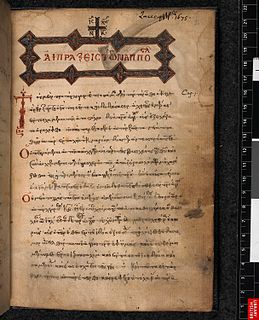Related Research Articles
Codex Vaticanus Graecus 2061, usually known as Uncial 048, α1 (Soden), is a Greek uncial manuscript on parchment. It contains some parts of the New Testament, homilies of several authors, and Strabo's Geographica. Formerly it was known also as the Codex Basilianus 100, earlier as Codex Patriniensis 27. It was designated by ב a, p.
Uncial 056 (in the Gregory-Aland numbering), O7 (von Soden), is a Greek uncial manuscript of the New Testament, dated paleographically to the 10th century.
Uncial 075, Οπ3 (Soden), is a Greek uncial manuscript of the New Testament, dated palaeographically to the 10th century. Formerly it was designated by ג. It was also classified as minuscule codex 382p.

Minuscule 33, δ 48 (Soden), before the French Revolution was called Codex Colbertinus 2844. It is a Greek minuscule manuscript of the New Testament on parchment, dated palaeographically to the 9th century. The manuscript is lacunose. It has marginalia. According to the textual critics it is one of the best minuscule manuscripts of the New Testament.
Uncial 0150 (in the Gregory-Aland numbering), X2 (in the Soden numbering), is a Greek uncial manuscript of the New Testament. It is dated paleographically to the 9th century.
Uncial 0151 (in the Gregory-Aland numbering), X21 (in the Soden numbering), is a Greek uncial manuscript of the New Testament. It is dated paleographically to the 9th century.
Uncial 0243, is a Greek uncial manuscript of the New Testament. Paleographically it has been assigned to the 10th century.
Minuscule 2423, is a Greek minuscule manuscript of the New Testament, on 227 parchment leaves ; it is dated paleographically to the 13th century.

Minuscule 1424, δ 30 is a Greek minuscule manuscript of the New Testament, written on 337 parchment leaves. It has been dated paleographically to the 9th or 10th century).
Minuscule 203, α 203 (Soden), is a modern Greek minuscule manuscript of the New Testament, on parchment. Paleographically it has been assigned to the 12th century.
Minuscule 254, ΟΘ42 (Soden), is a Greek minuscule manuscript of the New Testament, on paper. Palaeographically it had been assigned to the 11th century. Formerly it was labelled by 251a, 301p, 122r. Scrivener labelled it by 201a, 396p, 86r. It has marginalia.
Minuscule 256, α216 (Soden), is a Greek-Armenian minuscule manuscript of the New Testament, on parchment. Palaeographically it has been assigned to the 11th century. It was adapted for liturgical use.

Minuscule 322, α 550 (Soden), is a Greek minuscule manuscript of the New Testament, on paper. Palaeographically it has been assigned to the 15th century. Formerly it was labelled by 27a and 33p.
Minuscule 323, α 157 (Soden), is a Greek minuscule manuscript of the New Testament, on parchment. Palaeographically it has been assigned to the 12th century. Formerly it was designated by 29a and 35p.
Minuscule 365, δ 367 (Soden), is a Greek minuscule manuscript of the New Testament with some parts of the Old Testament, on parchment. Paleographically it has been assigned to the 12th century. It has marginalia.
Minuscule 383, α 353 (Soden), is a Greek minuscule manuscript of the New Testament, on parchment. Paleographically it has been assigned to the 13th century. Formerly it was labelled by 58a and 224p.
Minuscule 442 (in the Gregory-Aland numbering), O18 (in the Soden numbering), is a Greek minuscule manuscript of the New Testament, on parchment. Palaeographically it has been assigned to the 12 or 13th century. Formerly it was assigned by 68a and 73p. It shared all these designations with Minuscule 441, with which it now comprises a single codex.
Minuscule 453, A πρ40, is a Greek minuscule manuscript of the New Testament, on a parchment. Palaeographically it has been assigned to the 14th century. Formerly it was labelled by 81a.
Minuscule 618, α 261, is a Greek minuscule manuscript of the New Testament, on parchment. Palaeographically it has been assigned to the 12th century. The manuscript is lacunose. Tischendorf labeled it by 142a and 178p.
Minuscule 918, O 66, is a 16th-century Greek minuscule manuscript of the New Testament on paper, with a commentary. The manuscript is famous for the Comma Johanneum.
References
- 1 2 K. Aland, M. Welte, B. Köster, K. Junack, Kurzgefasste Liste der griechischen Handschriften des Neues Testaments, Walter de Gruyter, Berlin, New York 1994, p. 190.
- ↑ Aland, Kurt; Aland, Barbara (1995). The Text of the New Testament: An Introduction to the Critical Editions and to the Theory and Practice of Modern Textual Criticism . Erroll F. Rhodes (trans.). Grand Rapids: William B. Eerdmans Publishing Company. p. 137. ISBN 978-0-8028-4098-1.